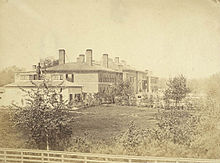|
Legislative Assembly of the Province of Canada
The Legislative Assembly of the Province of Canada was the lower house of the Parliament of the Province of Canada. The Province of Canada consisted of the former province of Lower Canada, then known as Canada East (now Quebec), and Upper Canada, then known as Canada West (now Ontario). It was created by The Union Act, 1840. Canada East and Canada West each elected 42 members to the assembly for the first four parliaments. In 1853, following the 1851 Canadian census, the number of seats in the assembly was increased by the 4th Parliament of the Province of Canada from 84 to 130, 65 for each section, even though Canada West had a slightly larger population. The Parliamentary Representation Act of June 1853 was to take effect with the election for the 5th Parliament of the Province of Canada.[1][2] The upper house of the legislature was called the Legislative Council. The two houses, the lower house and the upper house, constituted the Parliament of the Province of Canada. (See List of Parliaments below) The first session of parliament began in Kingston in Canada West in 1841. The second parliament and the first sessions of the third parliament were held in Montreal. On April 25, 1849, rioters protesting the Rebellion Losses Bill burned the parliament buildings. The remaining sessions of the third parliament were held in Toronto. Subsequent parliaments were held in Quebec City and Toronto, except for the last session June–August 1866 of the eighth and final parliament, which was held in the newly built Parliament building in Ottawa, the capital chosen for the Dominion of Canada. The British North America Act of 1867 divided the Province of Canada into the provinces of Ontario and Quebec, each province having its own Legislative Assembly, as well as representation in the Parliament of Canada. Seat of Government and Parliament Buildings    Parliament for the United Provinces of Canada drifted around the cities of Toronto, Kingston, Montreal, Quebec City and Ottawa. For exhaustive detail on how Parliament tried to resolve the issue of a permanent capital, see below David B. Knight, Choosing Canada's Capital: Conflict Resolution in a Parliamentary System (Carleton Library Series, 1991).
List of Parliaments
SpeakersThe role of speaker began a tradition of alternating between English and French Canada. This tradition carried onto the role of the Speaker of the House of Commons of Canada.
See also
References
Reading
External links
|
|||||||||||||||||||||||||||||||||||||||||||||||||||||||||||||